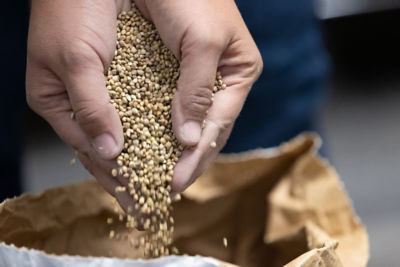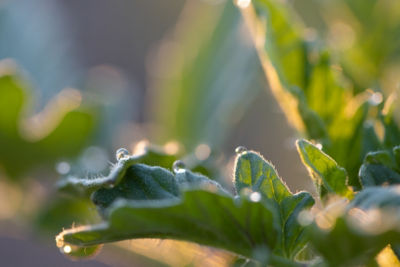Click here to download a PDF version of this spotlight
» Optimal cucumber production requires appropriate site selection, along with proper planting, and irrigation practices.
» Both bare ground and plasticulture systems are used for commercial slicing cucumber production.
» Adequate pollination can be key to proper fruit formation.
Three basic types of cucumbers are grown in the U. S.; slicing or fresh market types that are usually eaten uncooked; pickling types that are shorter and lighter in color than slicing cucumbers, normally used for processing into pickles; and the European burpless types, which are produced in greenhouse systems.1 This article will focus on production of the slicing/fresh market types.
SITE SELECTION AND TEMPERATURES
Cucumbers can be grown on most soil types. However, they perform best in soils with good moisture holding capacity and water infiltration rates. Soil pH levels should be between 5.8 and 6.6. If pH levels are below 5.8, lime applications can be used to adjust the level into the optimum range.
Cucumbers are very sensitive to cold temperatures. They can be easily injured by frost, and growth will be slow at temperatures below 50°F. Optimum soil temperatures for germination and growth are between 70 and 80°F, with air temperatures between 70 and 85°F.1 Seeds or transplants should be planted after soil temperatures are above 60°F and when air temperatures remain above 50°F.2
BARE-GROUND VS. PLASTICULTURE SYSTEMS
Slicing cucumbers are grown in both bare ground and raised bed, plasticulture systems. Bare ground systems have lower input costs, but earlier production and higher yields are usually seen in the plasticulture systems.
Black plastic mulch over raised beds (Figure 1) results in higher soil temperatures early in the season, promoting rapid germination and earlier fruit development. In the warmer summer months, white-on-black plastic mulch is used to prevent the soil from over heating. Additional benefits of the plasticulture system include weed control, increased irrigation efficiency, especially with drip irrigation systems, and better fertilizer management. The disadvantages of these systems include the higher cost of production and the need to dispose of the plastic mulch at the end of the season.3
 Figure 1. Cucumbers growing in a raised bed, plastic mulch system.
Figure 1. Cucumbers growing in a raised bed, plastic mulch system.
Double cropping cucumbers following tomato, eggplant, or peppers, using the same beds, mulch, and irrigation system can spread production costs, including the costs of soil fumigation, over two crops, while not risking problems with mutual diseases and pests.1
In either system, cucumbers can be direct seeded or grown from transplants. Starting with transplants can result in an earlier crop, but the added costs of purchasing or growing transplants may not always be economically justified.
PLANT SPACING
Spacing recommendations for cucumbers vary somewhat among states and growing regions. For bare ground production, University of Florida-IFAS guidelines recommend planting on 48 to 60 inch rows, with a plant-to-plant, in-row spacing of 6 to 12 inches.1 The Cornell Extension guidelines recommend row spacings of 60 to 72 inches with in-row spacings of 10 to 15 inches,4 and the Midwest Production Guide recommends row spacings from 48 to 72 inches with in-row spacings of 15 to 18 inches.5 However, planting with 6 inch in-row spacing is not uncommon in the Midwest.
Plasticulture systems can be arranged with one or two rows per bed. For two row systems, a 10 to 18 inch spacing between rows is recommended with beds on 48 to 72 inch centers. Within rows, holes in the mulch are spaced every 8 to 10 inches, with one or two plants per hole.1
FERTILIZATION
Fertilizer application rates of nitrogen (N), phosphorus (P), and potassium (K) should be based on soil type and annual soil nutrient tests. Again, recommendations vary somewhat from state to state, but most recommendations call for 60 to 100 pounds of N per acre, and 40 to 120 pounds of P (P2O5 equivalent) and K (K2O equivalent) per acre.1,2,3,4,5
Typically, about half of the fertilizer is applied to the soil before planting or banded over the row at planting. The remaining amounts are put on as one or two early season sidedress applications, usually when plants begin to vine out. Lower overall levels of N can often be used in mulched systems because the mulch reduces the amount loss from leaching due to rain or overhead irrigation. With drip irrigation systems, the post-plant applications can be made through the drip system (fertigation) at rates of 3 to 6 pounds per acre per week.1,5
IRRIGATION
Cucumber plants need between 1 and 2 inches of water per week for optimum production and fruit quality. Plants have a higher demand for moisture during pollination and fruit development.1,5 Irregular watering, especially during the bloom and fruit development stages can result in misshapen fruit, hollow fruit, carpel separation, or hooked fruit.4,5 Overhead sprinkler, drip, and seepage irrigation systems are all used in commercial cucumber production.1 Drip systems are typically the most efficient in terms of water usage per acre. They can be used to deliver nutrients to the root zone; they can reduce weed growth between rows; and they minimize leaf wetness, which can lead to increased disease. However, they may require more management effort, and drip tape needs to be replaced, usually every season.
POLLINATION
In addition to adequate soil moisture, proper fruit development requires adequate levels of pollination. Cucumber plants produce male and female flowers, and pollination requires the presence and activity of pollinators, mostly bees, to move pollen from the male to the female flowers. Multiple pollinator visits per flower are required to adequately pollinate the fruit, and good plant and pollinator management can be crucial for successful production.
Cucumber varieties differ in the types of flowers they produce. Standard cucumbers are monoecious, meaning that they produce both male and female flowers on the same plant, with male flowers producing pollen, and fruit developing only from female flowers (Figure 2). A majority of the flowers on these varieties are male. Some varieties are gynoecious, producing only female flowers. These varieties need to be planted near pollenizer varieties that produce male flowers because they do not produce any pollen of their own. Some varieties are “predominantly female”, producing mostly female flowers, and there are some experimental varieties that are hermaphroditic, where flowers have both male and female structures. The type and number of flowers present on a variety is important to consider, as special steps may be needed to ensure an adequate supply of pollen. If gynoecious or predominantly female varieties are planted, pollenizer plants with male flowers will need to be planted along with the production variety.3 Most seed companies will pre-package pollenizer varieties in the bag, eliminating the need to purchase a separate pollenizer variety.
It is also important to make sure that an adequate number of active pollinators (usually honey bees) are present during the pollination period. A typical recommendation is to provide one active honey bee hive per acre of cucumbers.2 However, declines in native bee populations has resulted in a recommended rate of two hives per acre in some areas.3
 Figure 2. Female (left) and male (right) cucumber flowers.
Figure 2. Female (left) and male (right) cucumber flowers.
Care must be taken to protect bees from nearby insecticide applications, and growers should coordinate activities with the bee keepers. It is best not to apply any insecticides during the pollination period. However, if an insecticide application is necessary, the time of application is very important in reducing bee exposure. Bees are present in cucumber plantings and pollinate most actively in the morning and early afternoon. So applications of any pesticides should be made late in the day, preferably near dusk.2
SOURCES
1 Larson, B.C., Mossler, M.A., and Nesheim, O.N. 2014. Florida Crop/pest management profiles: Cucumbers. UF IFAS Extension. CIR 1255.
2 Orzolek, M.D., Kime, L.F., Bogash, S.M., Harper, J. K. 2010. Cucumber production. Agricultural Alternatives. Penn State. UA463.
3 Kelly, T., Granberry, D., and Boyhan, G. 2009. Commercial production and management of squash and cucumbers (B 1178). University of Georgia Extension.
4 Reiners, S. and Seamen, A. 2016. Cornell integrated crop and pest management guidelines for commercial vegetable production.
5 Egel, D.S. 2016. Midwest vegetable production guide for commercial growers.
ADDITIONAL INFORMATION
For additional agronomic information, please contact your local seed representative. Developed in partnership with Technology Development & Agronomy by Monsanto.
Individual results may vary, and performance may vary from location to location and from year to year. This result may not be an indicator of results you may obtain as local growing, soil and weather conditions may vary. Growers should evaluate data from multiple locations and years whenever possible. The recommendations in this article are based upon information obtained from the cited sources and should be used as a quick reference for information about cucumber production. The content of this article should not be substituted for the professional opinion of a producer, grower, agronomist, pathologist and similar professional dealing with this specific crop
SEMINIS DOES NOT WARRANT THE ACCURACY OF ANY INFORMATION OR TECHNICAL ADVICE PROVIDED HEREIN AND DISCLAIMS ALL LIABILITY FOR ANY CLAIM INVOLVING SUCH INFORMATION OR ADVICE. 160525095554 0909116DME




